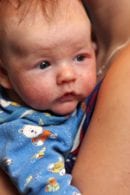Baby All of a Sudden Has Red Splotches on Right Side of Face and Turned Blue

Terminology and Types of Common Childhood Rashes
You are dressing your 3-year-old child when you notice a rough, pimply red rash on her back and chest. You also find it on her arms and legs. What could it be? Should you call the doctor?
You pick your 6-year-old up from school and notice his cheeks are bright red. He feels a little warm and then shows you a red lacy rash on his arms. You rush over to the doctor's office, afraid this rash might be caused by some unusual illness

An hour after dinner you are giving your one-year-old a bath. You notice a red and white, raised welt on her tummy. You find more on her legs. Fifteen minutes later she is completely covered in welts. What could this be? Should you rush her to the ER?
[rp4wp]
Rashes are common during childhood. From viral infection rash to food sensitivities to the fever and rash toddlers can experience from roseola. Children are constantly exposed to a variety of illnesses and irritants that can cause rashes. The purpose of this site section is threefold:

- To help you recognize several of the most common childhood rashes,
- To help you figure out what the cause of your child's particular rash might be and how to treat it,
- Most importantly to help you decide if a rash is dangerous and requires an urgent page to your doctor or if it can wait until the next day to be evaluated.
Rashes are rarely urgent and almost never require an urgent page to your doctor. In fact, there is basically only one rash that requires immediate medical evaluation – this is a rash called petechiae or purpura, which involves ruptured blood vessels under the skin. We will discuss later how to recognize this rash. Virtually all other rashes can wait until you can call your doctor's office to schedule an appointment. Diaper Rashes are discussed in a separate section.
Rash Terminology
It is important for you to understand the words we will use in this discussion to describe a rash. This will also help you more accurately describe a rash to your doctor's office over the phone.

- Raised – this means you can feel a bump when you rub your fingers over the rash.
- Flat – opposite of raised. The rash is flush with the skin and can't be felt.
- Lacy – this looks as if someone placed a piece of fancy lace material over the skin and then removed it, leaving a red imprint of the lace on the skin.
- Pimply – this refers to very small raised bumps with a tiny white head in the middle, just like a pimple.
- Bumps – this means exactly when it sounds like – a raised bump.
- Spots – this refers to flat spots that can't be felt.
- Blistery – this means a bump with clear fluid-filled middle.
- Pustule – a pus-filled blister.
- Welt – this is a raised, part red and part skin-colored area. It can be small or large. An example of a welt is hives.
- Blotches – like a welt, but flat, and usually not a uniform color – parts are red and parts are flesh-toned.
- Patch – this refers to a flat area of the skin larger than just a little bump.
- Trunk – the chest, tummy, and back.
Most Common Rashes in Children
Here are the most common childhood rashes. Read through them to see if any seem to match your child's rash. If not, then the following section may help you identify the rash. None of these 5 rashes warrants an urgent page to your doctor unless you feel your child is unusually ill.
Hives
These are welts. They can appear suddenly out of nowhere and can spread rapidly. They are most common on the trunk, but can also be on the extremities, and rarely on the face. A very distinct characteristic of hives is that each welt will often come and go over a period of 10 to 15 minutes or as long as a few hours. You will see some welts on the tummy, and then look again an hour later and find them gone, only to see new ones on the back.
The welts can be small or very large, round or irregularly shaped, single or clustered together, and over-lapping. They usually itch, but not always. Hives appear when the body has an allergic reaction to a variety of things. Variables such as foods, medications, external irritants such as soap, detergent, clothing material, or grass can cause an allergic reaction. Children can also get hives during a normal illness such as a cold or fever. Because this is an allergic reaction, you need to observe your child for other signs of a severe allergic reaction such as throat tightness, wheezing, breathing difficulty, or persistent vomiting. Go to the ER if these happen. The standard treatment for hives is Benadryl.
Eczema
There are two factors that can cause eczema. First, a genetic tendency toward dry, irritated skin; and second, skin allergies to a variety of irritants and foods. Childhood eczema has two different appearances… When this rash is mild it looks like flat, dry, white patches. During flare-ups, it appears as red, irritated, raised patches. This rash characteristically occurs on the inner elbows and behind the knees in infants and young children.
In older children, it usually affects the front of the knees and outside of elbows. In can also appear on the trunk, face, hands, and feet. Your child can have as little as one patch or dozens. Eczema can either be a short-lived temporary reaction to something in your child's environment, or it can be a chronic condition lasting for years. The diagnosis and treatment of childhood eczema is extremely involved. The standard treatment is hydrocortisone cream 1%, over the counter.
Viral Rash
It's common for a viral rash to appear out of the blue. There is a variety of viruses that can cause this type of rash. Some viruses are easily identifiable such as chickenpox, fifth disease, and roseola.Most viruses, however, do not cause their own specific type of rash as chickenpox does. These generic viral rashes can have many different appearances, such as lacy or pimply, raised or flat, bumps, spots, or blotches, and they often (but not always) start on the trunk, and then spread to the extremities. The most important thing to understand here is that if your child has a fever or is not feeling well, and breaks out in one of these generic rashes, then it is probably a harmless virus and nothing to worry about.
Here is a brief description of some identifiable viral rashes:
Chickenpox
This starts off with a few red spots or bumps (often mistaken for insect bites). Fever is common. The next day many more bumps will appear, and the first bumps will have turned into blisters. On the third day, new bumps will appear, and the second-day bumps will start to blister. On day 4 the original blisters will start to crust over. Usually, by day 5, no new bumps will appear, and more blisters will crust over. On day 7 the majority of blisters will crust over. The fever can last for 5 days. Contagion ends when the fever stops and all the blisters crust over. If this sounds like what your child has, click here for a complete discussion in chickenpox.
Very important note – it is nearly impossible to diagnose chickenpox on day 1, and still difficult to know for certain on day 2. Therefore, do not bring your child in to the doctor on day 1 or 2 and expect a definite diagnosis. Is this viral rash contagious? Yes, it is, so if you think it's chickenpox, quarantine your child until day 3. If the spots have progressed as described above, then you probably don't even need a doctor to confirm it. Viral rash getting worse? Dr. Sears advises: when you first notice some spots, draw a circle around a few of them. If they change into blisters within 24 hours, consider it chickenpox.
Note: There is a highly effective chickenpox vaccine available to your child. Read about the vaccine here.
Fifth disease (or Slapped Cheek disease)
This is a very common virus. It starts out causing bright red cheeks that resemble slapped cheeks and sometimes a fever. Then a generic lacy or pimply rash spreads from the trunk to the extremities. There may also be a runny nose and cough. If this sounds like what your child has, click on it for a detailed discussion.
Coxsackie: Blisters on hands, feet, or mouth
Coxsackie is a virus that produces blisters on the hands, feet or mouth. Click here for a picture.
The Contagious Period for Viral Rashes
It's worth noting that the questions of "How long does a viral rash last?" and "How long a viral rash is contagious?" have different answers depending on what illness your child may have. In general, viral illnesses are contagious starting the day before the rash and fever begin. Contagion ends when the fever breaks for 24 hours (and no Tylenol has been given to hide the fever), even though the rash will continue. Chicken Pox is the exception (see above).
Roseola
This is one of the most common causes of fever and rash in infants and young children. It starts out with three days of moderate to high fevers, with no other symptoms. On day four the fever breaks and your infant develops a rash yet acts almost entirely well. The rash consists of red spots and bumps starting on the upper back and neck, spreading down the trunk and into the extremities. It sometimes has a lacy appearance. If this sounds like what your child has, then click here for more information on roseola.
Insect Bites
This is a very common occurrence in children, even if you don't have pets, and you clean the house regularly. If your child develops several (generally less than 20) red bumps with a visible pinpoint hole in the middle, then it is probably an insect bite.
Heat Rash
This appears as tiny red pimples, bumps, or spots. It usually appears on the back of the neck or lower back, but can involve the entire trunk. It occurs due to a mix of sweat, heat, and clothing. Treat this by cooling your baby off, airing out the area, or applying a cool washcloth.
Contact Rash
There are two types of contact rash.
The first type of contact rash appears as red, raised bumps or patches, and can have a slightly crusty surface. It is extremely itchy. They can also run in a line on the skin from the irritant being scratched along the skin. This is often initially confined to one or two small areas on the body. However, they may spread over the next few days. It is caused by contact with an irritant such as poison ivy, other plants, cleaners, or other chemicals. Notice the red raised patch with crusty drainage in the middle. Notice the straight lines of rash due to scratching and spreading the poison.
This type of contact rash is treated with over-the-counter hydrocortisone 1%, calamine lotion, and Benadryl liquid for severe itching. Stronger prescription creams can be used if needed. You can prevent this type of rash by applying a lotion to the skin prior to adventuring, and then rinsing the skin after returning home, with a special lotion available at sporting goods stores. One such brand is Tech-Nu, but any brand should work.
The second type of contact rash is more generalized throughout the body, very similar to the generic viral rashes discussed above. It occurs as fine, red pimples, or small spots. It can be caused by a huge variety of irritants such as new clothes, soaps, shampoos, bubble baths, detergents or fabric softeners, suntan or other lotions, bed sheets, grass, swimming pools, or anything else that comes into contact with your child's skin. The treatment is to figure out the cause, and use hydrocortisone as above if needed.


Impetigo
Impetigo is a bacterial infection in the skin that can occur just about anywhere but is most common around the mouth and nose. It appears as red, raised bumps or patches with a honey-colored crust on the surface. It is treated with a prescription antibiotic ointment.
Facial Rashes
Virtually all infants and young children will get a rash around the mouth and cheeks at some point during their childhood. It usually appears as flat patches, or slightly raised patches, with tiny red bumps scattered around the mouth and chin. For baby, rash around the mouth can be caused by drooling, pacifiers, allowing smeared food to remain too long on the face, or rubbing the face against parent's clothes.
This rash will often remain for weeks at a time. Just when it seems to finally clear up, something irritates it again and it returns for another few weeks. In time, this will clear up for good, and no treatment is really necessary. If its appearance bothers you, you can try applying Aquaphor healing ointment, lanolin ointment (used for sore nipples during breastfeeding), or hydrocortisone 1% cream twice a day until clear. But be warned, it will probably come back.
Ringworm
This appears as a red, raised ring, with almost normal skin in the middle. Itching is common. There can be any number of these rings, from just one to 10 or more. This isn't a viral rash, it is caused by a fungus. It is transmitted from other infected animals or people. A general rash of fine, red bumps can appear elsewhere on the body – this is an allergic reaction to the fungus that causes the rash. The treatment is over-the-counter Lotrimin AF (clotrimazole) twice a day for several weeks, or until clear. See our article on Ringworm for a more detailed discussion and a photo.
Warts
Warts are fairly obvious and typically occur on the hands and feet.
Molluscum warts
Molluscum warts are another type of wart, but have a different appearance and usually occur on the chest or upper thighs. They are smooth, skin-colored bumps that have a dimple in the center and usually occur in clusters. The size can vary, from the tip of a ball-point pen to about half the size of the eraser end of a pencil. They can also itch.
These are the most common rashes in children. Unless your child is acting extremely ill, none require an urgent call to the doctor or visit to the ER.
Caring for Common Childhood Rashes
Treating Childhood Rashes – When to See Your Doctor
After reviewing the above conditions and linked articles, this should help you in deciding if a doctor's visit is necessary for your child. Here are two general guidelines:
- You don't need to see a doctor if the rash isn't bothersome and your child is happy.
- Most of these rashes can stay around for weeks. They will eventually go away on their own – even if it stems from a virus that causes rash symptoms. Your doctor should evaluate any rash that persists for more than four weeks.
Treating Petechiae or Purpura – Doctor Required
THE ONE RASH THAT REQUIRES AN URGENT CALL TO YOUR DOCTOR OR ER VISIT RIGHT AWAY
Petechiae or purpura forms when blood vessels under the skin break open. Petechiae appear as tiny, red, pinpoint, flat spots. They look as if someone used a fine-tip red ink pen to put little dots on the skin. Purpura is similar, but is larger and can be more purple or blue in color. The two most important signs that you can use to distinguish these spots from other rashes are:
- They don't blanch when you press on them. Many other kinds of spots, when pressed, will turn white or skin-colored for 1 or 2 seconds, and then turn red again. Petechiae and purpura will stay red or purple. They won't blanch at all when pressed.
- They are completely flat. Because they occur under the skin, you won't be able to feel any bump.
There is one situation where petechiae are not urgent. If your child has a very bad cough or is vomiting, the pressure in the head can cause little blood vessels in the skin of the face and neck to rupture and form petechiae. THESE PETECHIAE ARE OK. THEY ARE NOTHING TO WORRY ABOUT.
PETECHIAE OR PURPURA FOUND ANYWHERE ELSE ON THE BODY BESIDES THE FACE AND NECK COULD BE A SIGN OF A BLEEDING PROBLEM OR A SERIOUS INFECTION. CONTACT YOUR DOCTOR IMMEDIATELY IF YOU SUSPECT PETECHIAE OR PURPURA.

Dr. Sears, or Dr. Bill as his "little patients" call him, has been advising busy parents on how to raise healthier families for over 40 years. He received his medical training at Harvard Medical School's Children's Hospital in Boston and The Hospital for Sick Children in Toronto, the world's largest children's hospital, where he was associate ward chief of the newborn intensive care unit before serving as the chief of pediatrics at Toronto Western Hospital, a teaching hospital of the University of Toronto. He has served as a professor of pediatrics at the University of Toronto, University of South Carolina, University of Southern California School of Medicine, and University of California: Irvine. As a father of 8 children, he coached Little League sports for 20 years, and together with his wife Martha has written more than 40 best-selling books and countless articles on nutrition, parenting, and healthy aging. He serves as a health consultant for magazines, TV, radio and other media, and his AskDrSears.com website is one of the most popular health and parenting sites. Dr. Sears has appeared on over 100 television programs, including 20/20, Good Morning America, Oprah, Today, The View, and Dr. Phil, and was featured on the cover of TIME Magazine in May 2012. He is noted for his science-made-simple-and-fun approach to family health.
Dr. Bill Sears
Baby All of a Sudden Has Red Splotches on Right Side of Face and Turned Blue
Source: https://www.askdrsears.com/topics/health-concerns/skin-care/rashes/
0 Response to "Baby All of a Sudden Has Red Splotches on Right Side of Face and Turned Blue"
Postar um comentário